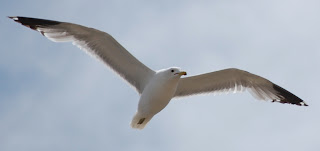For the most part, the San Francisco Zoo is very good about creating environments for the animals that are large and comfortable. The lovebirds, for example, had two large caged areas attached with a tunnel. The birds inside were very happy.
There was one exhibit, however, that was really awful for the birds. The hawks, turkey vultures, and owls were secured to stands by only three feet of rope and positioned in the blinding sun.

The hawks were only a foot away from the turkey vultures and the area was surrounded by people. The birds were clearly uncomfortable. You can see that this isn't their permanent housing, though, because there is only water provided for the birds. Hopefully they're only out for a few hours at a time.

This guy kept straining against the binds. He was so unhappy to be tied to the stand. He kept flapping his wings to take off, but his feet were bound. The restraints must be especially hard for such predatory birds.

Here's another one of him straining.

The turkey vultures felt threatened too and kept posturing for the people. Of course the public was excited to see his gorgeous wingspan, but if only they knew that he was trying to hide his vulnerability.


The section of the zoo with the maguari stork also housed a turkey vulture. It was a large enclosure, so I really hope that they return the other turkey vultures to that area too.
In the section with the owls, who were secured similarly, there were volunteers that explained how they only take in birds that cannot be released into the wild. One of the owls had been raised by humans; another contracted West Nile virus and had some neurological damage as a result. I'm thrilled that they take care of these birds, but I really wish that they would put these birds in a caged structure where they can fly.

 They have yellow beaks with a red spot.
They have yellow beaks with a red spot.
 This is a juvenile California gull. He's still wearing a first winter coat. Their bellies get increasingly white as they age.
This is a juvenile California gull. He's still wearing a first winter coat. Their bellies get increasingly white as they age. He looked really nice against the waves.
He looked really nice against the waves. Here's a bottom view of another juvenile.
Here's a bottom view of another juvenile. 














 and kept tipping it backwards
and kept tipping it backwards



















 This bird was so much fun to photograph! He flew up and down, on a variety of plants. I won't bore you with all the variations. I took over 100 pictures of these guys with my new 1 gig memory card. Here, she's very puffy!
This bird was so much fun to photograph! He flew up and down, on a variety of plants. I won't bore you with all the variations. I took over 100 pictures of these guys with my new 1 gig memory card. Here, she's very puffy! This was my favorite picture. Sparrow in profile:
This was my favorite picture. Sparrow in profile:
 In this one, I photographed both white-crowned sparrows and a song sparrow! Song sparrows are my favorite sparrow because they have the most beautiful songs. I could listen to them all day.
In this one, I photographed both white-crowned sparrows and a song sparrow! Song sparrows are my favorite sparrow because they have the most beautiful songs. I could listen to them all day. This host of house sparrows likes to hang out near my bird feeder, waiting for me to fill it. They are all female house sparrows. Male sparrows are distinguished by their black bib. I recycle Audrey and Conner's bird seed by giving it to the local birds, who are much less picky about the food. They're happy to eat pellets.
This host of house sparrows likes to hang out near my bird feeder, waiting for me to fill it. They are all female house sparrows. Male sparrows are distinguished by their black bib. I recycle Audrey and Conner's bird seed by giving it to the local birds, who are much less picky about the food. They're happy to eat pellets.



